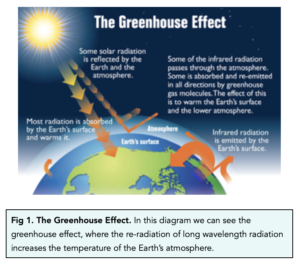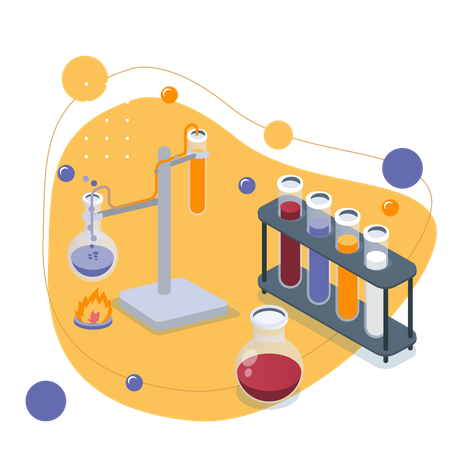Greenhouse Gases (GCSE Chemistry)
Greenhouse Gases
Greenhouses Gases
- Gases maintain the Earth’s temperature. Certain gases known as greenhouse gases maintain the Earth’s temperature. These gases ensure that the Earth has temperatures high enough to support life.
- Carbon dioxide is a greenhouse gas. Water vapour, carbon dioxide and methane are all greenhouse gases. As previously mentioned, these gases maintain the temperature of the Earth.
The Greenhouse Effect
- The greenhouse effect warms the Earth up. The greenhouse effect increases the temperature of the Earth. This effect involves the greenhouse gases we’ve mentioned previously.
- Radiation is involved in the greenhouse effect. The greenhouse effect relies on radiation, which can take two forms. These two forms are short wavelength radiation and long wavelength radiation.
- Greenhouse gases absorb long wavelength radiation. Of the two forms of radiation, greenhouse gases will absorb long wavelength radiation. They don’t absorb short wavelength radiation.
- Greenhouse gases re-radiate long wavelength radiation. After the greenhouses absorb the long wavelength radiation, they re-radiate it. The long wavelength radiation ends up being radiated towards the Earth.
- Long wavelength radiation is thermal radiation. Since long wavelength radiation is thermal radiation, it will increase the temperature of the Earth.

Worked example: Explain how the greenhouse effect keeps the earth warm (4 marks)
Model answer:
Short wave (uv) radiation from the passes through the atmosphere unchanged and hits the earth’s surface (1).
Energy from the uv waves is absorbed by the Earth, and the waves are re-radiated as longer wave length, infrared radiation to the atmosphere (1).
Greenhouse gases, like carbon dioxide, methane and water vapour absorb the infrared waves and heat up (1).
The heat is re-radiated back to earth and the temperature increases (1).
Increasing Atmospheric Greenhouse Gases
- Atmospheric greenhouse gases are increasing. In the Earth’s atmosphere, the amount of greenhouse gases are increasing. Examples of greenhouse gases include carbon dioxide and methane as we saw previously.
Specific Human Activities Increasing Greenhouse Gases
- Human activities contribute to increasing greenhouse gases. Certain human activities such as using fossil fuels increase the amount of greenhouse gases in the atmosphere.
- Fossil fuels combustion releases carbon dioxide. When fossil fuels are combusted for use in transportation, they release carbon dioxide. As we saw previously, this carbon dioxide had been previously locked up as carbon in the fossil fuels.
- Deforestation leads to more carbon dioxide. Trees can be removed through deforestation. This means that there are fewer trees available to photosynthesise and therefore less carbon dioxide is removed from the atmosphere.
- Increased waste increases methane. As waste production on Earth increases, more landfills are created. As the waste decomposes in landfills, methane gas. is released.
- Increased agriculture leads to increased methane. When farm animals are kept in agriculture, there is an increase in methane levels. During their digestive processes, farm animals produce methane which is released to the environment.
- Increased rice paddies leads to an increase in methane. Rice paddies grow in anaerobic conditions. Anaerobic bacteria within these rice paddies produce methane.
Greenhouse gases are gases in the Earth’s atmosphere that trap heat and cause the greenhouse effect. The most common greenhouse gases are carbon dioxide (CO2), methane (CH4), nitrous oxide (N2O), and fluorinated gases.
The greenhouse effect is a natural process that occurs when greenhouse gases in the atmosphere trap heat from the Sun, warming the Earth’s surface. This process is necessary for life on Earth, but an increase in greenhouse gas concentrations can lead to global warming and climate change.
The main sources of greenhouse gases are human activities, such as the burning of fossil fuels for energy and transportation, deforestation, and the production of certain industrial processes and waste. Agricultural practices, such as livestock production, also contribute to greenhouse gas emissions.
The burning of fossil fuels releases large amounts of carbon dioxide into the atmosphere, which increases the concentration of greenhouse gases and contributes to global warming.
Carbon dioxide is one of the most important greenhouse gases, and it plays a significant role in the greenhouse effect. Carbon dioxide absorbs and re-emits heat, trapping heat in the atmosphere and contributing to global warming.
An increase in greenhouse gas emissions can lead to global warming and climate change, causing rising temperatures, changing precipitation patterns, melting polar ice caps, rising sea levels, and more frequent and intense weather events.
To reduce greenhouse gas emissions, we need to transition to clean, renewable energy sources and adopt sustainable practices in transportation, agriculture, and industry. We can also reduce emissions by improving energy efficiency, reducing waste, and planting trees to absorb carbon dioxide from the atmosphere.
The Paris Agreement is a global agreement signed by countries around the world to take action to combat climate change and limit global warming to well below 2°C above pre-industrial levels. The goal of the Paris Agreement is to keep the global temperature rise within a safe limit and to help prevent the worst effects of climate change.
Carbon offsetting is a way to balance out your greenhouse gas emissions by funding projects that reduce emissions elsewhere. For example, you can offset the emissions from your flight by investing in a renewable energy project that will reduce emissions elsewhere.
Individuals can reduce their greenhouse gas emissions by making changes in their daily lives, such as using public transportation, reducing energy consumption at home, eating a more plant-based diet, and supporting clean, renewable energy sources. Every small action can help to reduce greenhouse gas emissions and combat climate change.






Still got a question? Leave a comment
Leave a comment